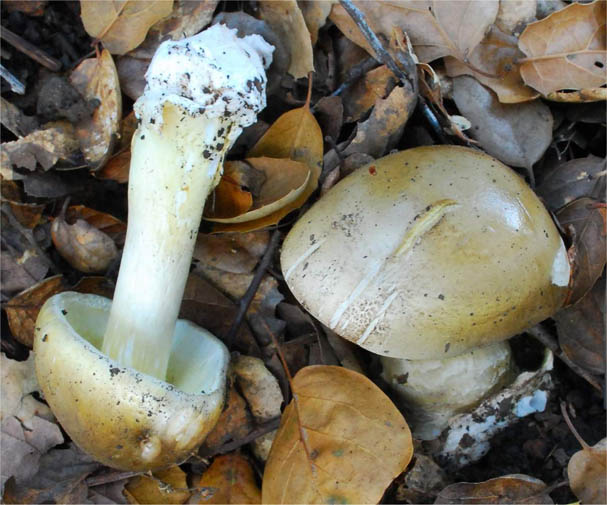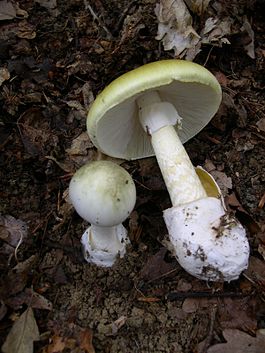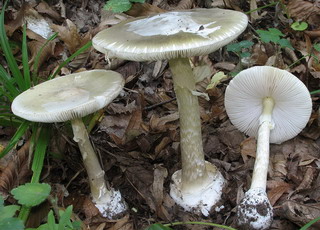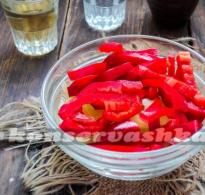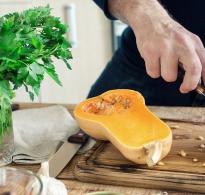Description of the white pale grebe. Death cap
Amanita phalloides (Fr.) Seer.
Death cap grows in coniferous and broad-leaved forests, birch forests, oak forests singly and in groups from June to autumn frosts. Occurs rarely.
Hat up to 10 cm in ∅, first bell-shaped, then flat-convex, light green, white, yellowish-brown-olive, usually darker in the middle, with a silky sheen, slimy in wet weather, sometimes with white flakes on the surface.
The pulp is white, thin, odorless and tasteless.
The plates are frequent, free, white. Spore powder is white. Spores are almost spherical, smooth.
Leg up to 12 cm long, 1.5-2 cm ∅, hollow, smooth, tuberous thickened at the base, white, sometimes with yellow tint surrounded by a white, cupped vagina. The ring on the leg is white, striped.
The pale grebe is deadly poisonous. Signs of poisoning appear after 8-12, sometimes 20-40 hours after eating. Inexperienced mushroom pickers may confuse this mushroom with some of the edible mushrooms.
Distribution: Pale grebe prefers deciduous and mixed forests (and better - broad-leaved), forms mycorrhiza with many deciduous trees, in particular, with linden and oak. Occurs from late July to late autumn.
Related Species: Confuse with floaters, especially when young. However, these species compare favorably with floats by the absence of a ring on the stem. The white variety of pale grebe can be confused with champignons - again at a young age, when the champignon plates have not yet darkened. It should be remembered that in pale grebe, unlike champignons, the plates remain white at any age. Mushrooms also completely lack a vulva. In order to eliminate unnecessary risk, you should not collect small separately growing champignons, the age of which does not allow you to confidently determine the presence or absence of the above signs. (Of course, this applies primarily to the places where the pale toadstool is distributed - in the open field, more indulgence can be shown to champignons.) There are also cases when the pale toadstool was collected instead of the green row (Tricholoma flavovirens), as well as instead of various green russula. Such absent-minded people can only be reminded that neither the rows nor the russula have a ring on the leg and a vulva. In addition, any member of the genus Russula is easy to distinguish from the pale grebe by touch.
Danger
Pale grebe can be very similar to some types of russula
Inexperienced mushroom pickers may take pale grebe instead of good edible mushrooms. It is especially often confused with various types champignon, green russula and greenish russula, with floats, with greenfinch. It should be remembered that champignons never have a Volvo and the plates quickly stain with age; russula has neither a volva nor a ring, and besides, they are distinguished by the characteristic fragility of the pulp; floats are smaller, have thinner flesh (they usually have pronounced radial grooves on the edges of their caps) and do not have a ring; greenfinch has greenish plates, there is no ring and volva.
There are known cases of erroneous collection of pale grebes when cutting mushrooms with a knife under the very hat, when the characteristic membranous ring remained on the ground along with the stem.
Ecology and distribution[edit | edit wiki text]
Forms mycorrhiza with various deciduous species (oak, beech, hazel), prefers fertile soils, light deciduous and mixed forests. Fruiting singly or in groups, common. The fungus is widely distributed in the temperate zone of Europe, Asia and North America.
Season: late summer - autumn.
Picture of poisoning
Poisoning occurs when pale grebe is eaten.
Heat treatment does not eliminate the toxic effect. ¼ of the average fruiting body (about 30 g) causes severe poisoning, usually ending in death in children.
Main symptoms: after ¼-2 days there is indomitable vomiting, intestinal colic, muscle pain, unquenchable thirst, cholera-like diarrhea (often with blood). There may be jaundice and an enlarged liver. The pulse is weak, thready. Arterial pressure reduced, there is a loss of consciousness. As a result of toxic hepatitis and acute cardiovascular insufficiency, in most cases - a fatal outcome.
A particular danger of the fungus lies in the fact that signs of poisoning do not appear for a long time. Symptoms may not appear for the first 6-24 hours or more, during which, however, the body is already poisoned and irreparably damaged. Once symptoms appear, mortality is very high and any treatment is often futile. A feature of intoxication is also a "period of false well-being", which occurs on the third day and usually lasts from two to four days. In fact, the destruction of the liver and kidneys continues at this time. Death usually occurs within 10 days of poisoning.
Chemical composition and mechanism of toxic action
The fruit bodies of the pale grebe contain bicyclic toxic polypeptides, which are based on the indole ring. The toadstool toxins studied so far are divided into two groups: amanitins (amatoxins, amanitotoxins) - more poisonous, but slower acting (give a purple color with cinnamic aldehyde in HCl vapor), and phalloidins (phallotoxins) - less poisonous, but faster acting ( blue stain with the same reagents). Amanin occupies an intermediate position (blue color is similar to phalloidins, but acts more slowly).
The amanitin group includes: α-amanitin (DL50 2.5 µg/20 g), β-amanitin (DL50 5-8 µg/20 g), γ-amanitin (DL50 10-20 µg/20 g). Phalloidins: phalloin (DL50 20-30 mcg/20 g), phalloidin (DL50 40 mcg/20 g), phallin B (DL50 300 mcg/20 g), fallacidin, phallalisin. The toxicity of amanin is 0.5 µg/kg. In 100 g fresh mushroom contains 8 mg α-amanitin, ~5 mg β-amanitin, 0.5 mg γ-amanitin and 10 mg phalloidin. For humans, the lethal dose of phalloidin is 20-30 mg.
In the pale grebe, a cyclic polypeptide antamanid was also found, which can reduce the toxic effect of phalloidin, and (to a lesser extent) α-amanitin. However, the content of antamanin in the fungus is insignificant and does not change the integral toxic effect.
Phalloidin and amanitin act mainly on the liver, affecting the endoplasmic reticulum and the cell nucleus of hepatocytes. Fallolysin causes lysis of hepatocytes and blood cells. Phalloidin (10−14-10−6 mol/l) reversibly blocks K+ channels of excitable membranes, reducing the outgoing potassium current in muscle fibers.
Under the influence of toxins of the pale toadstool, ATP synthesis is inhibited, lysosomes, microsomes and ribosomes of cells are destroyed. As a result of a violation of the biosynthesis of protein, phospholipids, glycogen, necrosis and fatty degeneration of the liver develop.
Edibility: One of the most poisonous mushrooms, a kind of phenomenon. Even spores and mycelium are poisonous. As you know, the poison of the pale toadstool, that is, amanitins and phalloidins, is very insidious - the first symptoms of poisoning appear only when the poison has already worked and it’s too late to do anything - one can only hope that the dose was not too high. Relatively lethal dose sources differ somewhat (obviously, following the actual fluctuations in the content of toxins in mushrooms depending on climatic and other conditions), but everyone agrees that this dose is very small. Some sources indicate that 1 g is enough for fatal poisoning. raw mushroom per 1 kg of live weight. If the figure is too high, then it is insignificant. It is known that one good copy of the pale grebe is capable of poisoning several people, and this is no longer the prejudice of Western reinsurers ...
Author's note: The pale grebe is very beautiful mushroom. Hardly the most beautiful. This is a real work of art. It is a masterpiece. No lopsided warty grebe. Solid aesthetics. Young radical-green specimens are especially beautiful: a geometrically adjusted hemispherical hat, dark green with ingrown dark veins, a leg of the correct thickness with soft greenish patterns, a neat white ring ... The instinct squeaks: “Eat me!”. And they do eat...
Mushroom pale grebe - is a representative of the genus of fly agaric. This mushroom looks attractive. Why is the pale grebe mushroom so dangerous?
Mushroom pale grebe in our forests appears in August and grows until late autumn. It occurs in light birch forests, conifers and oak forests. If it just tastes bitter, then the toadstool very often leads to the death of an unfortunate mushroom picker and his family.
Description of the fungus pale grebe
- The hat can be up to 12 centimeters in diameter. At young mushroom the cap is convex, when it reaches maturity, the cap becomes flat. The color of the cap can vary from white and greenish to olive. In the middle of the cap, the color is darker. In wet weather, the hat becomes covered with mucus. The wide bottom plates always remain white.
- The pulp is always white color, meaty. old mushroom has an unpleasant slight odor. Do not take it in your hands!
- The cylindrical leg can grow up to 12 centimeters. The white or greenish stem is hollow, expanding towards the base, greenish streaks are visible on the surface. At the base, the stem looks like a tuber. The characteristic features of this poisonous mushroom are the presence of a white ring on the stem and a thickening in the form of a tuber.
What mushrooms can be confused with pale grebe mushroom?
Inattentive and absent-minded novice mushroom pickers confuse this poisonous mushroom with green russula, champignon, greenish russula and a float. And the differences between a deadly poisonous mushroom and edible mushrooms are very significant. It is necessary to carefully look at the found mushroom and not rush to cut it off. Remember:
- In champignon, the plates are colored and there is no bulbous thickening on the stem.
- Russula does not have high and thin legs. There is no white ring on the legs. The flesh of russula is more fragile than that of grebe.
- The float is much smaller than the toadstool. The float does not have a white ring on the leg.
If you are not quite sure about the mushroom found, then it is better not to cut the mushrooms with a ring on the stem and a strong thickening at the base of the stem. Leave these mushrooms to grow in the forest.
What danger is fraught with mushroom pale toadstool
- The biggest danger and insidiousness of the toadstool is that the signs of poisoning become noticeable only after a day. During this time, the poison has already done its job, and it is too late to save the victim from poisoning.
- The victim is thirsty headache, weakness, vomiting. The pain starts in the stomach. Then comes the imaginary period of improvement. At this time, toxins destroy the patient's body. Further, the skin turns yellow and there is severe pain in the intestines and stomach. Ten days later, the poisoned person loses consciousness and dies.
- A lethal dose is only half a poisonous mushroom - about 30 grams. If a miracle happens and the poisoned person survives, then the consequences of poisoning will affect the rest of his life.
- It should be remembered that poison is not destroyed by heat treatment, boil and fry poisonous mushrooms is completely useless.
- Poison mushroom toxins affect the human liver. In addition, they very often damage the spleen, kidneys, heart.
If any mushroom poisoning appears or is suspected, it is urgent to seek medical help.
Death cap is one of the representatives mushroom kingdom, which is the most toxic of all species. This mushroom belongs to the amanitaceae family, the fly agaric genus. Mortality from its adoption can reach up to 80-90% of cases, although poisoning from this fungus is not so common. Therefore, try to look more closely at the pale grebe.
Pale grebe photo and description of a poisonous mushroom. The fruiting body of the fungus is a hat-legged. Young mushrooms hide their body under a film, having an ovoid shape. The color of the cap at the first stage of development is greenish or olive hue, then the color becomes lighter. Sometimes you can find a pale grebe with a completely white cap. As it grows, the hat flattens, and its size can reach 15 cm.
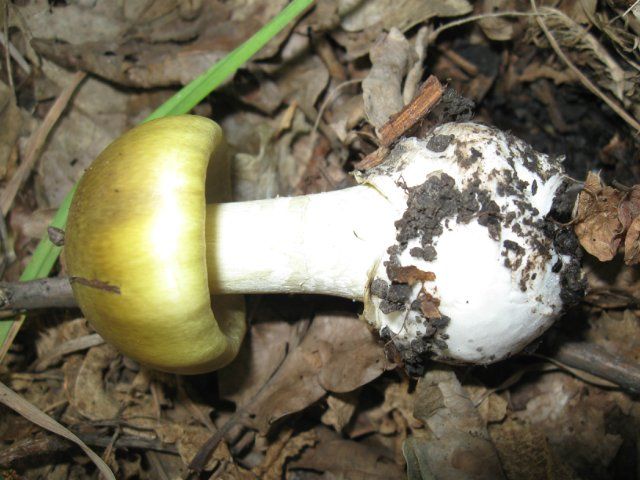
For mature mushrooms leg of pale grebe reaches 15 cm, but thin 1-2 cm. It has a strong ring, white, bag-shaped Volvo. Volva - white, cupped, wide, free, most often it is met torn and immersed in the soil. The stem is white and sometimes found with beautiful olive stains. The plates are frequent, wide, lanceolate, free. They are white, like the spores.
Pale grebe and champignon how can they be distinguished? This type of mushroom can very often be confused with young forest champignons(floats). However, they are distinguished by the absence of a ring on the leg of the pale grebe. Mushrooms have plates at a young age have pink color, but in the pale grebe they are always white.
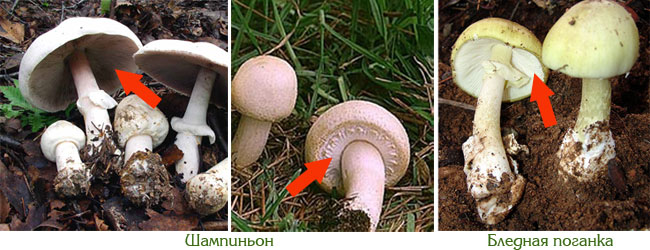
Pale toadstool symptoms occur 12-30 hours after poisoning, toxic substances begin to slowly destroy the human body. As usual, everything starts with a simple headache. But after some time there are burning pains in the stomach, deterioration of vision, restlessness, strong thirst. Further choleporous vomiting, diarrhea and convulsions. At times one can experience a sense of relief, but an irreversible process of change has already begun in the kidneys, liver, spleen and heart. When toxins have already entered the bloodstream, death usually occurs within 9 days. At suspicion of poisoning with this deadly fungus, it is better to immediately seek help from specialized institutions, there is a high probability that in the first hours the mortality rate decreases to 50%. Remember, if you are not 100% sure about a mushroom, it is better not to put it in the basket.
Pale grebe mushroom photo
